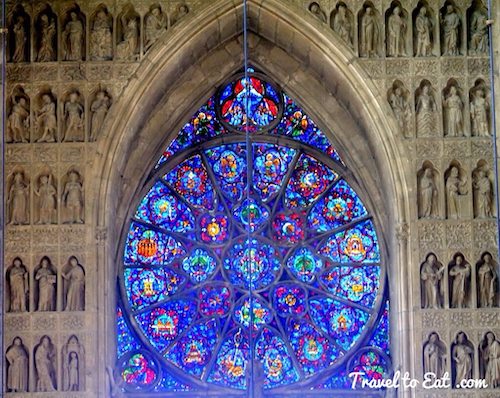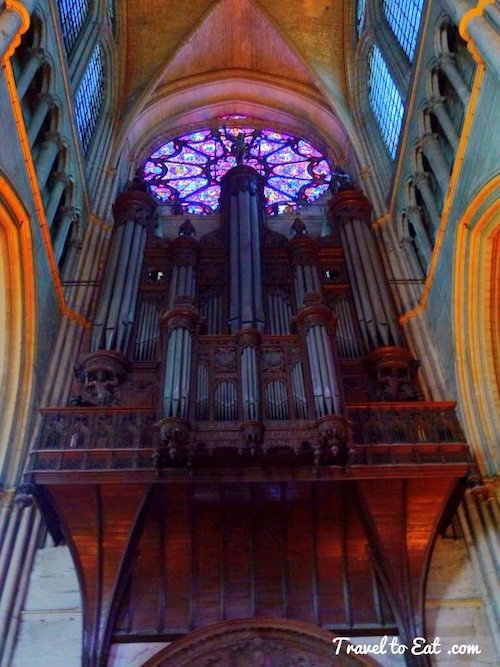
I have previously written about the exterior of Nore Dame de Reims cathedral. This post takes us through the interior. As you walk through the central portal of the western facade you can look back and see the beautiful stained glass above the portal. Of great importance in the early days of Christianity in Gaul, Reims had a number of archbishops who were major figures in the Roman Catholic Church, canonized after their death. This was the case for the most famous among them, Rémi (440-533) the archbishop who baptized Clovis and instituted the Holy Anointing of Kings. The ceremony was fully established in the 12th century, and after that time almost all French sovereigns were consecrated at Reims. For the Royal Anointing, which took place in the town's cathedral, the Ampulla containing the Chrism, or holy oil, was brought from the Abbey of Saint-Rémi. Rémi, who died in 533, was buried in St Christopher's chapel, which was replaced in the 11th-12th centuries by a Benedictine abbey church. The current cathedral replaced an older church, destroyed by fire in 1211, that was built on the site of the basilica where Clovis was baptized by Saint Remi, bishop of Reims, in AD 496. The cathedral was rebuilt in the13th-14th century.

In 1936, Ateliers Simon-Marq, created a second, smaller rose below the big one in order to replace the windows that were destroyed during World War I. Such an accomplishment, having two roses on the same wall, is very unique. Small rose has the virgin Mary placed in the center, where each of the rose petals represents her different qualities.




The stained glass above the north and south portals of the western wall correspond roughly to the themes on the gables above the portals. Thus the northern portal has a crucifixion theme with the symbol of the lamb of God in the center and the south portal shows symbols of the last judgement.


Between two roses on the western wall, stained glass evokes crowning of the king: the king is in the center dressed in a robe with a fleur-de-lis pattern and he is accompanied by 6 pairs of church officials and 6 pairs of dukes and counts. This represents a unique history of Reims cathedral, where kings were once crowned. Even though these windows are today extremely deteriorated, we can still recognize in the lancet windows, some figures attending the coronation of a king. The purpose of the Reims Cathedral, the “Coronation Cathedral”, was thus underscored. These panels were restored in the 16th century, perhaps during the time of Bishop Viventius (Saint Vivent), referred to in documents devoted to the history of medieval stained glass restoration. They were greatly damaged by a hail storm in 1886, and during the fire of the western façade in 1914.

The Champagne-Ardenne region possesses an extremely rich heritage of ancient glass production. Though the Cathedral has lost a portion of its original stained glass, it still holds some of the most remarkable Gothic examples of the art. To preserve this heritage, the State supports both the restoration of existing stained glass and the creation of new works. On the top of the western wall of the cathedral, one can see La Grande Rose. It dates from the end of the 13th century and it represents the Assumption of Mary. The rose is done in a circular pattern. In the middle of the big circle, virgin Mary is represented, surrounded with the first circle of 12 apostles, and then in the second one with 24 angel musicians who together with prophets and kings accompany Christ’s mother to heaven.








The organ of the Cathedral of Reims originates from 1487. The great organ was completely rebuilt in 1849 by John Abbey. It included 53 jeux. During the second half of the nineteenth century organ was changed, jeux were added. After the damage caused by the bombings of World War I, the organ was rebuilt by Victor Gonzalez. Completed in 1939, it included 87 stops over four manuals and pedal. The current organ is composed of jeux dating back from the 17th to 20th centuries, in a buffet built in 1647 covered with new woodwork produced by Jean Thury in the 17th century.

The end of the North Transcept is taken up by the organ and the North Rose window depicting Adam and Eve in the Garden of Eden. It dates from about 1231-1241, a remarkably ancient window.



The south transcept Rose Window shows Jesus surrounded by angels who are in turn surrounded by the 12 apostles. The South Rose was blown out in a storm in 1580 and received new glass the next year by Nicolas Dérodé. Dérodé's Rose was destroyed in WWI and was replaced by Jaques Simon in 1936. The original intent of the north and south Rose Windows was probably to indicate the beginning of time in the North Rose and the last judgement in the south. It is unfortunate that this window was lost.

In the original smaller Rose windows below the large South Rose illustrate the creatures of God's creation on the outer rim and a crown is depicted in the center surrounded by fleur-de-lis.

Finally, at the bottom, these three windows depict the Tree of Jesse, or the hereditary line of Jesus and by implication the divine right to rule given to the Kings of France.

The nave is well lit for a gothic cathedral and particularly bright at the transcept crossing where the Kings were crowned. On July 6, 1210 the cathedral was damaged by fire and reconstruction started shortly after, beginning at the eastern end. Documentary records show the acquisition of land to the west of the site in 1218, suggesting the new cathedral was substantially larger than its predecessors, the lengthening of the nave presumably being an adaptation to afford room for the crowds that attended the coronations. The area from the crossing eastwards was in use by 1241 but the nave was not roofed until 1299 (when the French King lifted the tax on lead used for that purpose). Work on the west facade took place in several phases, which is reflected in the very different styles of some of the sculptures. The upper parts of the facade were completed in the 14th century, but apparently following 13th century designs, giving Reims an unusual unity of style. Some of the stained glass is original although time, the elements, and wars have taken their toll.

These are some of the more modern stained glass windows of the cathedral. They were done in 1961 by Brigitte Simon-Marq where she tried to evoke light reflecting on a river by using blue-grey-green tones. Because these windows are modern and quite different from the traditional ones, their installation was opposed by the citizens of Reims. However, the funding was found and in my opinion, they look stunning, a real work of abstract art.

These three blue windows were done by Marc Chagall, combining blue hues that resemble the windows from the 13th century and more modern drawings. The central window evokes the history of Abraham and the last moments of the earthly life of Christ. The window on the left expresses the prophesy of the Old Testament. It depicts the Tree of Jesse, David and Solomon, and virgin Mary holding baby Jesus. The window on the right contains some motifs that describe the history of the cathedral: St. Remi blessing Clovis, first king of the Franks, and crowning of French kings.

In 816 the first royal coronation took place in Reims, the one of Louis the Pious, sole son of Charlemagne. The ceremony, which lasted five hours, took place in Notre-Dame de Reims Cathedral, as long ago as the Cathedral was built. It was followed by the coronation banquet in the Tau palace and a pilgrimage to the tomb of the bishop Remi, in the Basilica which bears his name. The most memorable coronation remains the one of the Dauphin Charles VII being led into Reims by Joan of Arc on July 17, 1429 after the raising of the siege of Orleans and the capture of Reims. In total, 33 kings were crowned in Reims, the last one being Charles X in 1825. By virtue of the outstanding handling of new architectural techniques in the 13th century and the harmonious marriage of architecture and sculpted decoration, Notre-Dame Cathedral at Reims is a masterpiece of Gothic art. The perfection of the architecture and the sculptural ensemble of the cathedral were such that numerous later edifices were influenced by it, particularly in regions of Germany. Notre-Dame de Reims is a beautiful cathedral, steeped in French and medieval history and someplace you should visit at least once in your life.
References:
Unesco: http://whc.unesco.org/en/list/601
Stained Glass: http://www.reims-cathedral.culture.fr/stained-glass-windows.html
Scholars in France: http://jsf2012.wordpress.com/2012/01/21/reims-cathedral-art-of-stained-glass/
The Rose Window: http://www.therosewindow.com/pilot/Reims%20cathedral/main.htm

